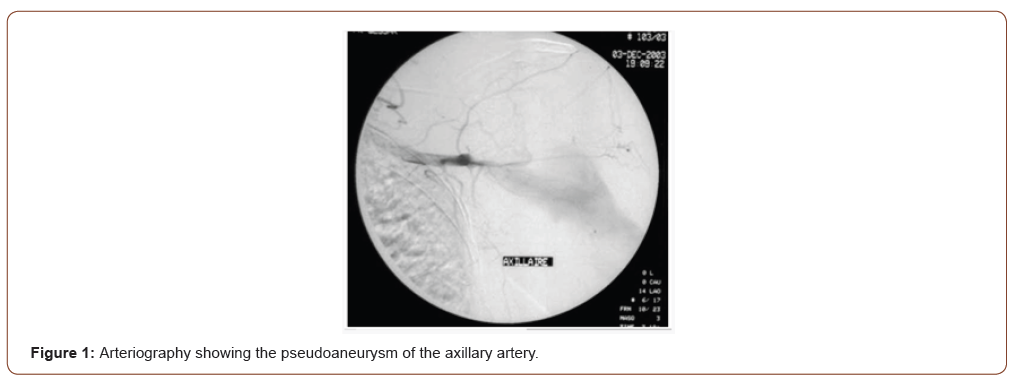 Mini Review
Mini Review
Brachial plexus palsy secondary to axillary artery pseudoaneurysm
Grimi Talal1*, Ouazzani Nabil2, Bassir R, Kharmaz M, Lamrani MO, Boufettal M, Mekkaoui J and Berrada MS
1Traumatology and Orthopedic Department, Ibn Sina Hospital, Morroco
2Medicine School at Mohammed V University, Morocco
Corresponding AuthorGrimi Talal, Traumatology and Orthopedic Department, Ibn Sina Hospital, Morroco.
Received Date: August 16, 2021; Published Date: September 15, 2021
Abstract
There are many etiologies of brachial plexus paralysis. They are dominated in adults by blunt trauma and wounds. We report the case of a 44-year-old patient who presented for a consultation with paralysis of the upper left limb that had progressed for four months. without any notion of trauma. The etiological assessment revealed a compressive pseudoaneurysm of the axillary artery secondary to Behcet’s disease. The revealing mode and the rarity of this etiology prompted us to report this interesting observation.
Introduction
Brachial plexus palsies are more and more common in young adults. The etiologies are dominated by closed trauma and wounds. Their prognosis is bad with a low chance of spontaneous recovery. Paralysis secondary to a compression of an arterial aneurysm is rare in outside the traumatic context. The slow evolutionary mode in this case is responsible for a delay in diagnosis and greatly influences the results of etiological treatment alone.

Observation
H.M. aged 44 years old. describes pain in the forearm and left hand, like dull burns with losing function, evolving for four months without any notion of trauma. Our attention was drawn from the start by total limb paralysis. On clinical examination: Edema and cyanosis of the upper left limb. Palpation shows mass at the deltopectoral groove, beating, blower evoking its vascular origin. A Doppler ultrasound notice the diagnosis of a pseudoaneurysm of the axillary artery, confirmed by arteriography (Figure 1).
The standard radiological assessment of the limb was normal. Emergency surgical exploration has brought evidence of a false aneurysm of the axillary artery with compression of the brachial plexus which was atrophic. A flattening of the aneurysm with bypass venous by the saphenous vein were made. Neurolysis of the different branches of the plexus. Brachial is has been associated. A postoperative electromyography objectified a total block which interest median, radial and ulnar nerves at the level of the arm. Reeducation of the limb has been started precociously. Six months later, we noted a discreet recovery of sensitivity in the territory of the median and ulnar nerves. An etiological assessment of the pseudoaneurysm concluded to Behcet’s disease.
Discussion
The brachial plexus is with an intimate connection with the axillary artery at the thoracobrachial outlet. Even a small aneurysm can be responsible for harmful compression for nerves, because all these structures are surrounded by the same fascia [1]. Compression is often insidious which is responsible for delayed diagnosis. The revealing clinical signs may be pain as in our case, most often located on the forearm or on the hand, like dull burns or overwrite, continuous from a few minutes to a few hours or very short feeling like electric discharges. This pain may be absent in more than 10% of cases [2]. Arterial and venous signs may be late as clinical expression or badly perceived by the examiner due to the small size of the aneurysm or developed musculature of the subject [3,4].
The treatment is first etiological by a flattening of the aneurysm and restitution of the vascular continuity by a graft. If the diagnosis is made early enough, the neurological lesions at this stage are essentialy neuroapraxia, decompression at this stage may help for a complete recovery of the neurological deficit. With our patient we opted for a conservative treatment of neurological damage time to carry out an etiological assessment of the pseudoaneurysm. When demyelization is established in consequence of prolonged compression, the recovery is absent or incomplete. The return of the motor function of some muscles depends on the distance between the muscle and the site of neurological lesions. Axonal regeneration takes place at a speed of 1 mm per day approximately which explains why the recovery of certain muscles such as intrinsic muscles of the hand can take months or even years. Unfortunately, when the time of the recovery is prolonged, there are irreversible changes secondary in the muscles denervated, which leads to a poor functional result even when axonal recovery is complete [5].
Conclusion
The upper limb performs an important function in everyday life. Lesions of the brachial plexuses secondary to compression aneurysm must be considered as a surgical emergency because their early management allows full recovery of the neurological deficit.
Acknowledgement
None.
Conflicts of Interest
No conflicts of interest.
References
- Braun RM, Newman J, Thacher B (1978) Injury to the brachial plexus as a result of diagnostic arteriography. J Hand Surg 3(1): 90-94.
- Alnot JY, Daunois O, Oberlin Ch, Bleton R (1992) Total brachial plexus paralysis by supraclavicular lesions. Review of orthopedic surgery 78: 495-504.
- Brawley RK, Murray GF, Crisler C, JL Cameron (1970) Management of wounds of the innominate, subclavian, and axillary blood vessels. Surg Gynecol Obstet 131(6): 1130-1140.
- Drapanas J, Hewitt RL, Weichert RF, AD Smith (1970) Civilian vascular injuries: A critical appraisal of the three decades of management. Ann Surg 172(3): 351-360.
- Nulsen FE, Kline DG (1973) Acute injuries of peripheral nerves, in Youmans JR (ed): Neurological Surgery. Philadelphia, WB Saunders Co, 2: 1089-1140.
-
Grimi Talal, Ouazzani Nabil, Bassir R, Kharmaz M, Lamrani MO, Boufettal M, Mekkaoui J, Berrada MS. Brachial plexus palsy secondary to axillary artery pseudoaneurysm. Glob J Ortho Res. 3(4): 2021. GJOR.MS.ID.000567.
-
Brachial plexus palsy, Axillary artery, Pseudoaneurysm, Paralysis, Diagnosis, Etiological treatment, Groove, Beating, Blower evoking, Ultrasound
-

This work is licensed under a Creative Commons Attribution-NonCommercial 4.0 International License.






